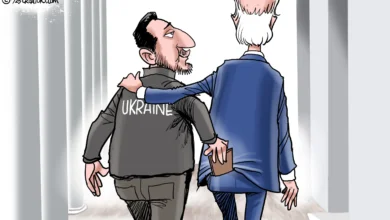DC’s Stance on Ukraine Is as Divorced From Reality as Its COVID Regime
Theirs not to make reply,
Theirs not to reason why,
Theirs but to do and die.
Into the valley of Death
Rode the six hundred.
From, “The Charge of the Light Brigade” by Alfred, Lord Tennyson
I was a fourteen-year-old freshman at St. Joseph’s Collegiate Institute in Kenmore, N.Y. when I was assigned my first term paper for Mr. Chaya’s World History class. The list of topics included the Charge of the Light Brigade. That’s the one I picked.
Like any boy that age, I still retained a belief in the glory of war, something Tennyson seems never to have outgrown. This despite being trained in grammar school to scurry from my desk and duck against the wall under the classroom window when the air raid siren sounded.
The possibility of being nuked by the Soviet Union at any moment had been a fact of life for all of my life at that point and would be for twelve more years.
The term paper assignment was the first time I was asked to research a historical event, rather than just read a textbook summary about it. By the time I finished, I had my first inkling that “military intelligence” might just be an oxymoron and perhaps war wasn’t the glorious affair Tennyson had cracked it up to be.
To this day, when I hear the lyrics, “a good old-fashioned, bullet-headed, Saxon mother’s son” in the Beatles song “Bungalow Bill,” I think of James Brudenell, 7th Earl of Cardigan, who led the aforementioned six hundred light cavalrymen into the teeth of Russian artillery.
The Charge of the Light Brigade occurred during the siege of Sevastopol during the Crimean War (1853-56). Despite the Light Brigade disaster, the port city finally fell to the British and French allies, but not before the Russian Empire sank its entire Black Sea fleet in the harbor to prevent it from falling into enemy hands.
That desperate act should provide a warning to Washington.
The Russians had to fight for Crimea again during the Russian Civil War following the Bolshevik revolution. It fell to the Germans during WWII after a bitter 250-day siege, only to be regained by the Red Army in 1944.
I never dreamed I’d be writing about the same port city thirty-six years after that first term paper. In 2016, the new global empire, the United States, having successfully orchestrated a color revolution to oust Ukrainian president Viktor Yanukovych, was in a stare down with Russian Federation president Vladimir Putin over his annexation of Crimea.
Yanukovich had been falsely portrayed as “pro-Russian” by NATO in its haste to bring Ukraine into the European Union. The coup was the last straw for Putin after watching the U.S. break its promise to Gorbachev not to advance NATO “one inch eastward” in exchange for Gorbachev’s agreement to the 1990 reunification of Germany.
A look at a map of NATO in the ensuing 30 years since that promise puts a somewhat different light on Russia’s troop buildup on the Ukrainian border and at least calls into question just who is the aggressor in this situation.
As I wrote back in 2016, Sevastopol is one of the few reliable Russian ports that remains ice-free all winter. Syria is home to another. If that doesn’t inspire skepticism regarding Washington, D.C.’s humanitarian motives for orchestrating regime change operations in both countries—while remaining bosom buddies with the brutal regime in Saudi Arabia—then, as my friends in the American southeast would say, “bless your heart.”
President Biden told Reuters on New Year’s Eve that he had warned Putin, “if he goes into Ukraine, we will have severe sanctions. We will increase our presence in Europe, with our NATO allies, and there will be a heavy price to pay for it.”
Sanctions don’t sound too ominous if one has zero historical perspective, including, say, the “sanctions” against the Japanese Empire in 1941. It doesn’t really matter who was right or wrong. Sanctions eventually lead to war if their consequences become dire enough.
It doesn’t matter so much who is right or wrong on the matter of Ukraine, either. The reality is this: The Russians are never going to give up that port. They’ve bled for it in the past far more than any American army has ever bled for anything. It is an existential matter for them.
In 1856, they sank their entire Black Sea navy before giving up Sevastopol. What would they be willing to do today?
Meanwhile, it makes not one iota of difference to Americans living in the United States if Russia annexed all of Ukraine, much less Crimea. Washington’s interests in the region are purely imperial and contrary to those of most U.S. citizens. It is also questionable that the U.S. could win a limited conflict in the region against Russia, given the logistics.
It is equally unrealistic that Russia could win a full-scale conventional war against NATO. The U.S. alone had a military budget in 2020 more than ten times that of Russia. That would leave Russia with only one alternative before surrender.
Since the dissolution of the Soviet Union in 1991, Washington has thought of itself as the “shining city on the hill” leading a “new world order” of democracy and peace. Considering its recent exploits in the Middle East and Ukraine, in 2021 it more resembles a drunk bully stumbling around the world slurring its words and picking fights with smaller opponents.
That Russia can be treated likewise is as divorced from reality as Washington’s belief it can stop the spread of a respiratory virus with lockdowns and vaccine mandates. But as damaging as the COVID Regime has been to American society, Washington’s delusions about bringing Russia to its knees could result in far worse.
This article was republished with permission from tommullen.net.
Content syndicated from Fee.org (FEE) under Creative Commons license.



